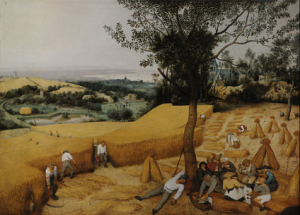UPDATE: The New York Times’ Roberta Smith took the Art Project on a long test drive and filed this excellent report on what works well and what still needs to be done, emphasizing that this is very much a work in progress.

By Bob Hicks
Say you have a hankering to see Hans Holbein the Younger‘s portrait The Merchant Georg Gisze but you just can’t get away to Berlin today to see it where it hangs, in the Gemäldegalerie.
You can always go online. But chances are that when you find it, the image will be pretty poor quality. And what if you want to examine it closely, to see Holbein’s brushstrokes or the effects of craquelure?
Then you might want to check out the new Google Art Project, which is bringing gallery tours and specific artworks together from 17 major international institutions, including the Gemaldegalerie. Not every great museum is on this list, but the 17 are pretty impressive.
Art Knowledge News has this report, and Philip Kennicott has a good news wrap, discussing the Project’s advantages and potential drawbacks, in the Washington Post.
 One of the advantages: The reproduction quality on specific works of art should be vastly better than what you can find on other Web sites. While it’s not as good as seeing a work firsthand — that remains the only way to truly experience a work of art in its fullest dimensions — it seems like a very good next-best, with the added advantage that you can examine surfaces in startling up-close detail. Here is Kennicott from his story in the Post:
One of the advantages: The reproduction quality on specific works of art should be vastly better than what you can find on other Web sites. While it’s not as good as seeing a work firsthand — that remains the only way to truly experience a work of art in its fullest dimensions — it seems like a very good next-best, with the added advantage that you can examine surfaces in startling up-close detail. Here is Kennicott from his story in the Post:
“On average there are 7 billion pixels” per image, said Amit Sood, leader of the Google Art Project. “This is a thousand times more than the average digital camera.”
“The giga-pixel experience brings us very close to the essence of the artist through detail that simply can’t be seen in the gallery itself,” said Julian Raby, director of the [the Smithsonian Institution’s Freer Gallery], in a statement. “Far from eliminating the necessity of seeing artworks in person, Art Project deepens our desire to go in search of the real thing.”
Here are the 17 leading institutions that have joined the project so far:
- Alte Nationalgalerie, Berlin
- Freer Gallery of Art, Smithsonian, Washington, D.C.
- The Frick Collection, New York
- Gemäldegalerie, Berlin
- The Metropolitan Museum of Art, New York
- The Museum of Modern Art, New York
- Museo Reina Sofia, Madrid
- Museo Thyssen – Bornemisza, Madrid
- Museum Kampa, Prague
- National Gallery, London
- Palace of Versailles, France
- Rijksmuseum, Amsterdam
- The State Hermitage Museum, St. Petersburg
- State Tretyakov Gallery, Moscow
- Tate Britain, London
- Uffizi Gallery, Florence
- Van Gogh Museum, Amsterdam
We’re adding the Art Project site to our Art Scatter links at right, in the ART/CRAFT category. Just click Google Art Project.
*
Pictured: Pieter Bruegel the Elder’s “The Harvesters” at the Metropolitan Museum in Art. Top image detail, inset full-frame, both from the Google Art Project.